Laptop Mag Verdict
The first bona fide iPad alternative features a compact design, dual cameras, snappy performance, and a small but growing number of tablet-friendly apps.
Pros
- +
Sleek and solid design
- +
Thumb-friendly keyboard
- +
Bright and crisp display with good viewing angles
- +
Core applications optimized for tablet use
- +
Dual cameras with video calling
- +
Fairly loud speakers
Cons
- -
No 4G
- -
Skimpy tablet app selection
- -
Shorter battery life than iPad
- -
Mail program does not support Google Apps accounts
Why you can trust Laptop Mag
The Galaxy Tab is everything the iPad is not. This 7-inch Android tablet is more compact, features two cameras (instead of none), and plays Flash videos. At the same time, Samsung's slate brings some welcome iPad-like features to the table, including a store for downloading movies and TV shows and a core of apps optimized for tablet use. At $399 with a two-year contract, plus a minimum of $29 per month for 2GB data, this tablet isn't cheap. Still, the Sprint version of the Tab is more affordable than the 3G iPad, costing $134 less over two years with comparable plans. (A contract-free version costs $599 and a Wi-Fi only Galaxy Tab will sell at Best Buy for $499.)
All of this sounds pretty promising, but the Galaxy Tab is everything the iPad is not in one other way: The Android Market simply doesn't stock many tablet-friendly apps yet. Then there's the small matter of whether 7-inch slates even make sense in the age of big-screen smart phones. So is the Galaxy Tab a tweener ahead of its time or a sweet little iPad alternative?
Design

Click to enlargeAfter seeing a wave of cheap Android tablets with shoddy build quality parade through our offices, the Galaxy Tab is a breath of fresh air. Weighing 13.5 ounces (compared to 1.5 pounds for the iPad), the Tab looks like an overgrown Galaxy S phone but with a more solid feel. It has an all-black front and a fashionable white back that curves slightly towards the outer edges. Backlit capacitive Menu, Home, Back, and Search buttons sit beneath the Tab's 7-inch screen, all of which were responsive. A 1.3-MP camera above the screen is there for making video calls.
A power button and volume rocker line the right side of the tablet, along with a microSD card that's relatively easy to access with a fingernail. (Inserting and removing a card proved tricky, however.) The top of the Tab has a 3.5mm headphone jack, and the back houses the 3-MP rear-facing camera and an LED flash. We would have preferred an industry standard microUSB port for charging this device, but at least the proprietary iPad-like connector can accommodate accessories such as docks.

Click to enlargeSo what about the 7-inch size? While the Galaxy Tab is lighter than the iPad, its 7.5 x 4.7 x 0.5-inch dimensions make it too big for your pants pocket. However, unlike the iPad, we could slip this slate into a jacket pocket--barely. The top edge of the device was peeking out. Women will appreciate that they can easily tote the Tab in medium-to-large purses, which is difficult or impossible to do with an iPad.
Display
No, it's not as jaw-dropping as the Super AMOLED screens found on Samsung's Galaxy S phones, but the 7-inch Galaxy Tab's display is still beautiful. This capacitive panel is bright, colorful, and boasts wide viewing angles. It's also pretty sharp, with a resolution of 1024 x 600 pixels that offers just a little less screen real estate than the 9.7-inch, 1024 x 768 iPad display. Other tablets with 7-inch displays or smaller have opted for 800 x 480, so Samsung is way ahead of similarly sized competitors. We just wish the glossy front didn't pick up fingerprints so quickly.
When watching a downloaded episode of 30 Rock from Samsung's Media Hub store, we were floored with the level of detail. We also found the 7-inch display to be highly accurate, even when clicking small links on web pages. Although we noticed some glare on the display when reading an Amazon book outdoors, pumping up the brightness helped increase legibility.
Keyboards
Samsung bundles the Galaxy Tab with two virtual keyboards: its own and one from Swype. Because this tablet is narrower than the iPad, we found it much easier to enter text, especially in portrait mode. We banged out a few lines in an e-mail reply just using our thumbs while making zero errors, though, as you type, you'll certainly notice this device's heft relative to a smart phone. Samsung's layout has plenty of space between the keys, as well as long-press shortcuts for numbers in the top row.

Click to enlarge
We appreciated that @ and .com keys showed up when we typed in an e-mail address field, and that the .com button was present when typing URLs in the browser. A welcome optional predictive text feature suggests words as you type.
With the Swype keyboard option, you can quickly enter text by drawing a continuous line from letter to letter, and the software is smart enough to enter spaces between words. Plus, you can easily tap things such as periods and special keys in this mode. It's definitely worth a try.
Specs and Performance
Given the fact that the Galaxy Tab packs the same 1-GHz Hummingbird processor and PowerVR SGX540 graphics found in Samsung's latest smart phones, we expected snappy performance. And that's what we got the majority of the time. Swiping through menus was smooth, and most applications opened within a second. The Galaxy Tab also multitasks fairly well. With eight apps open, we could quickly jump to Pandora or Settings by long-pressing the Home button and clicking an icon. On a few occasions, however, the Galaxy Tab was slow to respond, such as when we had to press the Gmail icon a few times for the app to open. And while the accelerometer was generally fast, we noticed some lag in the browser.
When we ran various Android benchmarks, the Galaxy Tab came out on the higher end compared to various phones running the same OS, but it didn't beat all of them. For example, in Linpack for Android, Samsung's slate scored 13.1, which is better than the Epic 4G (7.9) and HTC Incredible (6.5), but behind the T-Mobile G2 (28.7) and Motorola Droid 2 (13.9). However, in An3DBench, which measures graphics performance, the Galaxy Tab's score of 7,123 beat every Android phone we've tested.
The Galaxy Tab comes with a pretty paltry 2GB of onboard memory, but the tablet includes a 16GB microSD card (with support of to 32GB). You can use this space for media as well as apps.
Software
There's been a lot of debate as to whether Android 2.2 (Froyo) is really ready for tablets. It's not, but Samsung has done a lot of work on top of the OS to optimize it for a larger display. The Galaxy Tab's three slick home screens and app menus look very similar to Samsung's Galaxy phones. The widget selection includes Feeds, Updates--which streams updates from Facebook, MySpace, and Twitter, and a nifty Daily Briefing Widget that displays the news headlines, stocks, weather, and your next appointment at a glance (see image below). And just like Galaxy S handsets, the black app menu is reminiscent of the iPhone and iPad.

Click to enlarge
It's what Samsung has added to core applications such as Calendar, Contacts, E-mail, and Messaging that makes this Android tablet stand out. All of the above apps have a split screen-view when you use the Galaxy Tab in landscape mode so you can see more information at once. For example, in E-mail you can see your list of messages on the left and a preview on the right. And in the calendar (pictured below) you can see a monthly view on the left and today's agenda on the right. These iPad-like enhancements help the Galaxy Tab feel less like a phone.
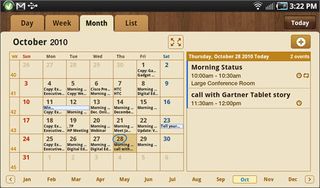
Click to enlarge
Most of these applications worked well, but we ran into some issues with the E-mail app. Although it lists Gmail as an option, it wouldn't recognize our Google Apps account. (Yahoo Mail worked fine). Even when we manually entered the POP settings, the app wouldn't fetch new messages. We wound up using Google's Gmail app, which also comes preloaded, instead.
Although it's borrowed from the phone line, we continue to appreciate the extra features Samsung makes accessible from the drop-down notification window. You'll find quick shortcuts for toggling the Wi-Fi and Bluetooth, GPS, Silent, and an Orientation Lock, plus a screen brightness slider.
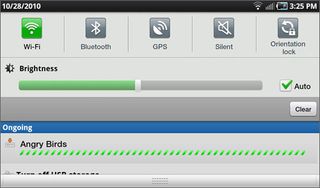
Click to enlarge
To help this Galaxy Tab stand out from the models that will be available on the other three major carriers, Sprint will be rolling out Sprint ID packs. These packs of apps, ringtones, wallpapers, and widgets will help users customize their devices with little effort, leveraging brands including EA Games, ESPN, MTV, and Notre Dame. We found that Sprint ID slows down the performance of Sprint's lower-end Android phones, but we have high hopes that the Galaxy Tab's hardware will be able to handle the overhead.
Web Browsing and Hotspot App
We were hoping that Sprint's Galaxy Tab would have 4G under the hood for blazing fast downloads, but instead you'll have to live with 3G speeds. In our tests, the tablet downloaded various sites at a decent clip, but not as fast as we'd like. The Galaxy Tab took 12 and 15 seconds, respectively, to download the mobile versions of NYTimes.com and ESPN.com, and a respectable 32 seconds to download the desktop version of Laptopmag.com. Oddly, the slate took close to a minute to download mobile CNN.com, but only 5 seconds to load a news story.
We wish there was an option to force the Tab to download full desktop sites instead of mobile sites. If you want that surfing experience, you're better off downloading the Dolphin HD browser. Then again, because of the Tab's small display, it's difficult to read text without zooming in when you're viewing sites in portrait mode. This isn't an issue on the iPad's larger 9.7-inch screen (see comparison below).
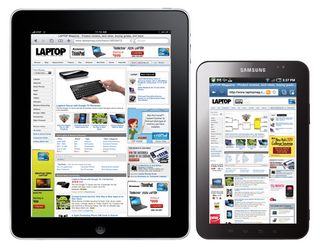
Click to enlarge
Overall, scrolling was fast and pinch-to-zoom worked well (with the exception of some minor stuttering). We also like the tab menu that shows up to six windows at one time.
If you want to use your tablet as a mobile hotspot, you can pay $30 per month to use the bundled Sprint Hotspot app and connect up to five Wi-Fi devices at once. Speedtest.net showed throughput ranging from 224 Kbps to 540 Kbps on the downlink, and 44 Kbps to 307 Kbps uploads, so don't expect swift performance if you connect your laptop.
Flash Support
As the Galaxy Tab supports Flash, we put this tablet to the test first by playing an episode of How I Met Your Mother on CBS.com. The device warned us that the video wasn't optimized for mobile, so we weren't surprised to see choppiness during playback. Still, it was watchable, and the audio was in sync with the video. We also tried an Adobe Air-enabled game called MeteorStormM. While this missile command-like title was fun to play, the graphics were jaggy and low-res.
Samsung Media Hub

Click to enlarge
For those who want to watch premium TV shows and movies to go, Samsung's Media Hub offers downloads over Wi-Fi on the Galaxy Tab from MTV Networks, NBC Universal, and Paramount. That's not a wide selection, and we quickly realized that it wasn't very timely, either. For example, under Top 5 Action flicks, we saw Robin Hood but also the original Iron Man and 300. Pricing for rentals ranged from $2.99 to $3.99, and you can purchase movies for $17.99, but we noticed that many titles couldn't be rented at all. TV shows cost $1.99 to own, with no rental option.
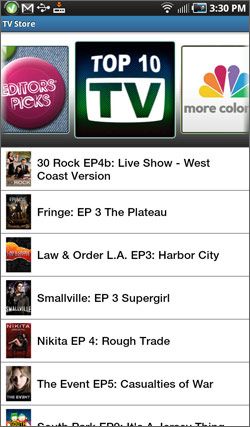
Click to enlarge
In addition, the movies you buy are trapped on the Galaxy Tab; you can't output them via HDMI or DLNA, though Samsung says it will make a desktop version of its software available in the future. With the upcoming iPad software update, you'll be able to stream iTunes content to a nearby Apple TV wirelessly.
On the plus side, thanks to Samsung's Progressive Download feature, you can start watching videos within as little as ten seconds. In the meantime, the file will continue to download in the background. It took the Galaxy Tab a decent 4.5 minutes to bring down an episode of 30 Rock, which we could watch almost immediately. And as we mentioned above, the quality was spectacular. Samsung just needs to beef up the content, add TV rentals, and look at subscription models. Still, even if Samsung does all that, Galaxy Tab owners will have to manage different accounts for video apps, downloads, and music. Apple makes it simple with one account.
Maps and GPS

Click to enlarge
The Galaxy Tab's 7-inch screen is large but certainly serviceable for turn-by-turn spoken directions via the free Google Navigation. You don't even have to type in an address. We simply said "Navigate to" followed by the street and state and the Galaxy Tab started looking for a route. That's impressive. Otherwise, Google Maps worked as you'd expect, with fast local search and Latitude support. You can spring for Sprint Navigation for $2.99 per day or $9.99 per month, but the free option is good enough.
Video Calling
Samsung bundles the Qik application to take advantage of the front-facing 1.3-MP camera, and we performed a test call with another Qik contact. All we had to do was enter her user name to start chatting. The quality was just okay, and this was over Wi-Fi. We could certainly make out the other caller, but we noticed a fair amount of pixilation, and the audio was out of sync with the video. Athough our first call didn't drop over Wi-Fi during our five-minute conversation, subsequent calls did drop.
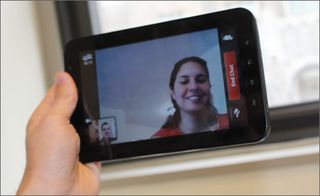
Click to enlarge
Just like Apple's FaceTime, you can switch between the front and back cameras on the fly. However, if you change your tablet's orientation, the other caller needs to do the same. In addition, Qik doesn't offer a PC client, so you can't make calls between the Galaxy Tab and a desktop.
Music, Photos, and Video
The Galaxy Tab's music player looks different than what you'll find on Samsung's phones. For example, when you select an album you'll see a pop-up window that shows the track list, which you can then scroll through--without opening a new window. We also like the huge album art during playback, though we don't get why the music player doesn't work in landscape mode.
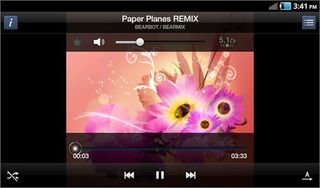
Click to enlarge
Music sounded nice and loud through the Tab's stereo speakers--so long as we stayed away from the harsh-sounding max setting. If you want to shop for your tunes, your best bet is to download the Amazon MP3 store, which isn't pre-loaded.
The Galaxy Tab steps down from the Galaxy S phones' 5-MP cameras and 720 video to a 3-MP camera and 720 x 480 camcorder. Considering the iPad doesn't have a camera at all, it's hard to complain. The tablet quickly took a shot of a fruit stand on an overcast day, which exhibited good color accuracy but lacked detail further back in the shot.
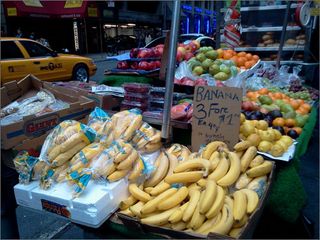
Click to enlarge
Video we recorded of traffic whizzing by in New Jersey was a bit blurry but certainly usable for sharing on YouTube, and the Galaxy Tab did a better job than we anticipated of handling low-light conditions. If you're taking stills in a dimly lit room, the LED flash will kick in. It blew out some details but overall worked well.
Battery Life
Samsung packs the Galaxy Tab with a 4000mAh battery, which is more than twice the capacity of what you'll find in a smart phone. The company claims you should see 7 hours of movie playback, and Sprint claims up to 13 hours of active use time. We ran our Android battery test on the tablet, which surfs the web continuously every minute with the display on 40 percent brightness. Using its 3G connection, the Galaxy Tab turned in a runtime of 5 hours and 36 minutes before turning off, but it had 12 percent of its capacity left. That's pretty good endurance for a device with a 7-inch screen, and we anticipate that the slate will last at least 7 hours over Wi-Fi. (Stay tuned for those results.) Nevertheless, the larger iPad Wi-Fi + 3G lasted 8 hours and 21 minutes, and closer to 10 hours over Wi-Fi.
Accessories
Samsung plans to make a wide variety of add-ons available for the Galaxy Tab. These options will include a keyboard dock ($99), multimedia desk dock with HDMI output ($49.99), and a car/gps dock ($99), among other accessories.
Pricing and Value

Click to enlarge
The Galaxy Tab costs $399 with a two-year contract and is offered with two data plans. The 2GB plan includes unlimited messaging for $29.99, while the 5GB plan costs $59.99. If you don't want a contract, you can buy the tablet for $599, but the pricing for data is the same. By comparison, AT&T's iPad plans start at just $14.99 per month (albeit for just 250MB for data) and go up to $25 per month for 2GB of data. That's also cheaper than Sprint's comparable plan, but you don't get text messaging.
If you were to compare the pricing of the AT&T iPad to the price of the Galaxy Tab, you would be talking about a total over two years of $1,229 versus $1,029, so Samsung's device would cost you less in the long run. However, we wish Sprint offered cheaper plans for those who paid full price for the slate. The two-year total for the contract-free version comes out to $1,295 with the 2GB plan, which isn't that much more than the iPad.
Best Buy plans to offer a Wi-Fi-only version of the Galaxy Tab for $499, which is a better value if you don't plan to travel with the tablet much. The Wi-Fi-only iPad is the same price.
Verdict
Samsung deserves credit for being the first to company to truly challenge the iPad with a piece of hardware that's well designed and easier to take with you..The ability to make video calls and free GPS navigation also shouldn't be overlooked, as well as the apps Samsung bundles that are optimized for tablet use. Still, the Galaxy Tab isn't for everyone. Those who already own a smart phone with a larger screen may not like the idea of toting a device that's not much bigger, especially one that comes with its own data plan (should you decide to go the 3G route). We also think consumers would prefer one place to purchase music, TV shows, and videos--if not apps, too--similar to iTunes. Nevertheless, once Android developers get their tablet acts in gear, the Galaxy Tab will be an even more formidable iPad foe.
Samsung Galaxy Tab (Sprint) Specs
| Brand | Samsung |
| CPU | 1GHz Cortex A8 Hummingbird CPU |
| Camera Resolution | 3MP |
| Card Reader Size | 16GB |
| Card Readers | microSD |
| Company Website | http://www.samsung.com/us/ |
| Display Resolution | 1024x600 |
| Display Size | 7 |
| Front-Facing Camera Resolution | 1.3MP |
| Graphics Memory | 128MB |
| Has Bluetooth | Yes |
| OS | Android 2.2 |
| Ports | Headphone, Proprietary |
| RAM Included | 512MB |
| Size | 7.5x4.7x0.5 inches |
| Storage Drive Size | 2GB |
| Storage Drive Type | Flash Memory |
| Weight | 13.6 ounces |
| Wi-Fi | 802.11b/g/n |

